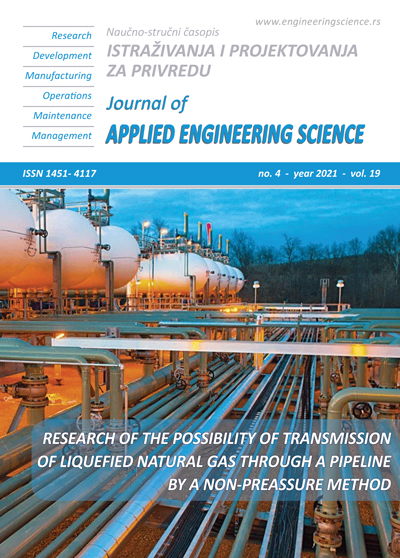ON ESTIMATION OF STRESS-STRENGTH RELIABILITY USING LOWER RECORD VALUES FROM ODD GENERALIZED EXPONENTIAL - EXPONENTIAL DISTRIBUTION
Abstract
This research paper aims to find the estimated values closest to the true values of the reliability function
under lower record values and to know how to obtain these estimated values using point estimation methods
or interval estimation methods. This helps researchers later in obtaining values of the reliability function in
theory and then applying them to reality which makes it easier for the researcher to access the missing data
for long periods such as weather. We evaluated the stress–strength model of reliability based on point and
interval estimation for reliability under lower records by using Odd Generalize Exponential–Exponential
distribution (OGEE) which has an important role in the lifetime of data. After that, we compared the
estimated values of reliability with the real values of it. We analyzed the data obtained by the simulation
method and the real data in order to reach certain results. The Numerical results for estimated values of
reliability supported with graphical illustrations. The results of both simulated data and real data gave us the
same coverage.
References
from Proportional Reversed Hazard Family,” American Journal of Mathematical and Management Sciences,
vol. 39, no. 3, pp. 234–251, Jul. 2020, doi: 10.1080/01966324.2020.1722299.
[2] A. Hassan, H. Muhammed, and M. Saad, “Estimation of Stress-Strength Reliability for Exponentiated
Inverted Weibull Distribution Based on Lower Record Values,” BJMCS, vol. 11, no. 2, pp. 1–14, Jan. 2015,
doi: 10.9734/BJMCS/2015/19829.
[3] A. S. Hassan, M. Abd-Allah, and H. F. Nagy, “Bayesian Analysis of Record Statistics Based on Generalized
Inverted Exponential Model,” International Journal on Advanced Science, Engineering and Information
Technology, vol. 8, no. 2, Art. no. 2, Mar. 2018, doi: 10.18517/ijaseit.8.2.3506.
[4] B. Tarvirdizade and H. Kazemzadeh Garehchobogh, “Interval Estimation of Stress-Strength Reliability Based
on Lower Record Values from Inverse Rayleigh Distribution,” Journal of Quality and Reliability Engineering,
vol. 2014, pp. 1–8, 2014, doi: 10.1155/2014/192072.
[5] A. Chaturvedi and A. Malhotra, “Estimation and testing procedures for the reliability functions of a family of
lifetime distributions based on records,” Int J Syst Assur Eng Manag, vol. 8, no. S2, pp. 836–848, Nov.
2017, doi: 10.1007/s13198-016-0531-2.
[6] A. Chaturvedi and S. Vyas, “Estimation and Testing Procedures for the Reliability Functions of Three
Parameter Burr Distribution under Censorings,” Statistica, vol. Vol 77, pp. 207-235 Pages, Jan. 2018, doi:
10.6092/ISSN.1973-2201/6965.
[7] F. Condino, F. Domma, and G. Latorre, “Likelihood and Bayesian estimation of $$P(Y{<}X)$$ P ( Y < X )
using lower record values from a proportional reversed hazard family,” Stat Papers, vol. 59, no. 2, pp. 467–
485, Jun. 2018, doi: 10.1007/s00362-016-0772-9.
[8] M. J. S. Khan and Mohd. Arshad, “UMVU Estimation of Reliability Function and Stress–Strength Reliability
from Proportional Reversed Hazard Family Based on Lower Records,” American Journal of Mathematical
and Management Sciences, vol. 35, no. 2, pp. 171–181, Apr. 2016, doi: 10.1080/01966324.2015.1134363.
[9] A. Asgharzadeh, A. Fallah, M. Z. Raqab, and R. Valiollahi, “Statistical inference based on Lindley record
data,” Stat Papers, vol. 59, no. 2, pp. 759–779, Jun. 2018, doi: 10.1007/s00362-016-0788-1.
[10] A. Pak and S. Dey, “Statistical Inference for the power Lindley model based on record values and inter-record
times,” Journal of Computational and Applied Mathematics, vol. 347, pp. 156–172, Feb. 2019, doi:
10.1016/j.cam.2018.08.012.
[11] M. Z. Raqab, O. M. Bdair, and F. M. Al-Aboud, “Inference for the two-parameter bathtub-shaped distribution
based on record data,” Metrika, vol. 81, no. 3, pp. 229–253, Apr. 2018, doi: 10.1007/s00184-017-0641-0.
[12] C. Zhang and Y. Zhang, “Common cause and load-sharing failures-based reliability analysis for parallel
systems,” EiN, vol. 22, no. 1, pp. 26–34, Dec. 2019, doi: 10.17531/ein.2020.1.4.
15
[13] M. O. Mohamed, “Reliability with Stress-Strength for Poisson-Exponential Distribution,” j comput theor
nanosci, vol. 12, no. 11, pp. 4915–4919, Nov. 2015, doi: 10.1166/jctn.2015.4459.
[14] S. Vv, “New Odd Generalized Exponential - Exponential Distribution: Its Properties and Application,”
BBOAJ, vol. 6, no. 3, Apr. 2018, doi: 10.19080/BBOAJ.2018.06.555686.
[15] S. Kotz, Y. Lumelskii, and M. Pensky, The Stress-Strength Model and its Generalizations - Theory and
Applications. World Scientific Publishing Co. Pte. Ltd., 2003.
[16] “Smith, R.L. and Naylor, J. (1987) A Comparison of Maximum Likelihood and Bayesian Estimators for the
Three-Parameter Weibull Distribution. Applied Statistics, 36, 358-369. - References - Scientific Research
Publishing.”

